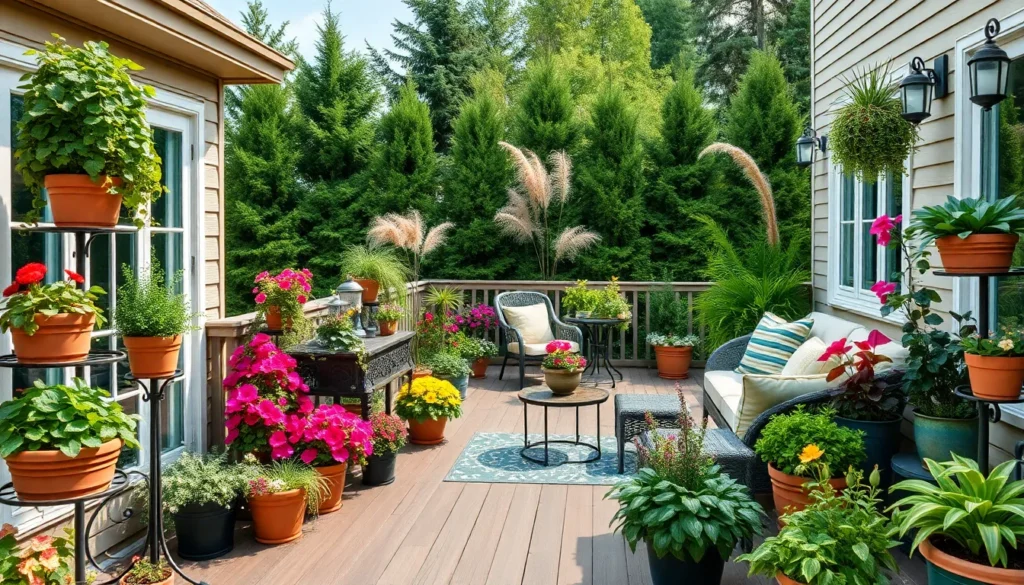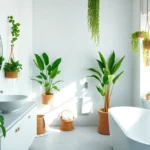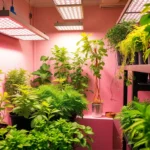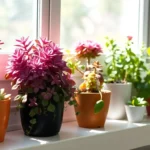Transform your outdoor deck into a stunning botanical paradise that’ll make your neighbors green with envy! Deck decorating with plants isn’t just about tossing a few pots around – it’s about creating a living masterpiece that extends your home’s beauty into the great outdoors.
We’ve discovered that the right plant combinations can turn even the most basic deck into an Instagram-worthy retreat. Whether you’re working with a sprawling space or a cozy corner deck, strategic plant placement creates depth, privacy, and that coveted outdoor room feeling we all crave.
From cascading flowering vines that provide natural privacy screens to carefully curated container gardens that add pops of color, plant-based deck decorating offers endless possibilities. We’ll show you how to maximize your space, choose plants that thrive in your exact conditions, and create seasonal displays that keep your deck looking fresh year-round.
Choose the Right Plants for Your Deck Environment
Selecting the perfect plants for your deck requires understanding your exact outdoor conditions. We’ll help you match plants to your environment for thriving container gardens and stunning deck displays.
Consider Sunlight Exposure and Shade Patterns
Full sun decks receive 6-8 hours of direct sunlight daily and support vibrant flowering plants like petunias, marigolds, and geraniums. These sun-loving varieties create colorful displays that brighten your deck decorating scheme throughout the growing season.
Partial shade areas get 3-6 hours of sunlight and work well with begonias, impatiens, and coleus. These plants offer beautiful foliage colors and delicate blooms that add visual interest without requiring intense sunlight.
Full shade decks receive less than 3 hours of direct sun but can still support attractive plants like hostas, ferns, and caladiums. These shade-tolerant options provide lush greenery and interesting textures that create serene outdoor spaces.
Track sunlight patterns on your deck throughout the day to identify the best spots for different plant types. Morning sun differs from afternoon sun in intensity, so we recommend observing your deck at various times before making plant selections.
Evaluate Wind Resistance and Weather Conditions
Choose sturdy plants with flexible stems and strong root systems for windy deck locations. Ornamental grasses like fountain grass and blue fescue bend gracefully in breezes while maintaining their attractive appearance.
Avoid top-heavy plants such as tall sunflowers or large-leafed tropical plants that can topple in strong winds. Instead, opt for compact varieties and dwarf cultivars that stay closer to containers.
Consider container weight when selecting plants for exposed decks. Heavy ceramic pots provide stability in windy conditions, while lightweight plastic containers may require additional anchoring or wind protection.
Plan for seasonal weather by choosing plants that can handle your area’s typical temperature fluctuations. Hardy perennials return year after year, while tender annuals may need protection during unexpected cold snaps.
Select Plants Based on Your Climate Zone
Determine your USDA hardiness zone to choose plants that survive your area’s coldest temperatures. Zone 3 gardeners need extremely cold-hardy plants, while Zone 10 gardeners can grow tropical varieties year-round.
Match plants to your zone for long-term success in deck decorating projects. Perennials rated for your zone will return each spring, providing reliable color and structure to your container displays.
Consider microclimates on your deck that may be warmer or cooler than your general area. South-facing decks often create warmer conditions, allowing you to grow plants from one zone warmer than your official rating.
Plan seasonal transitions by selecting a mix of cool-season and warm-season plants. Cool-season varieties like pansies and kale thrive in spring and fall, while warm-season plants like tomatoes and peppers prefer summer heat.
Create Vertical Garden Displays Using Wall Planters
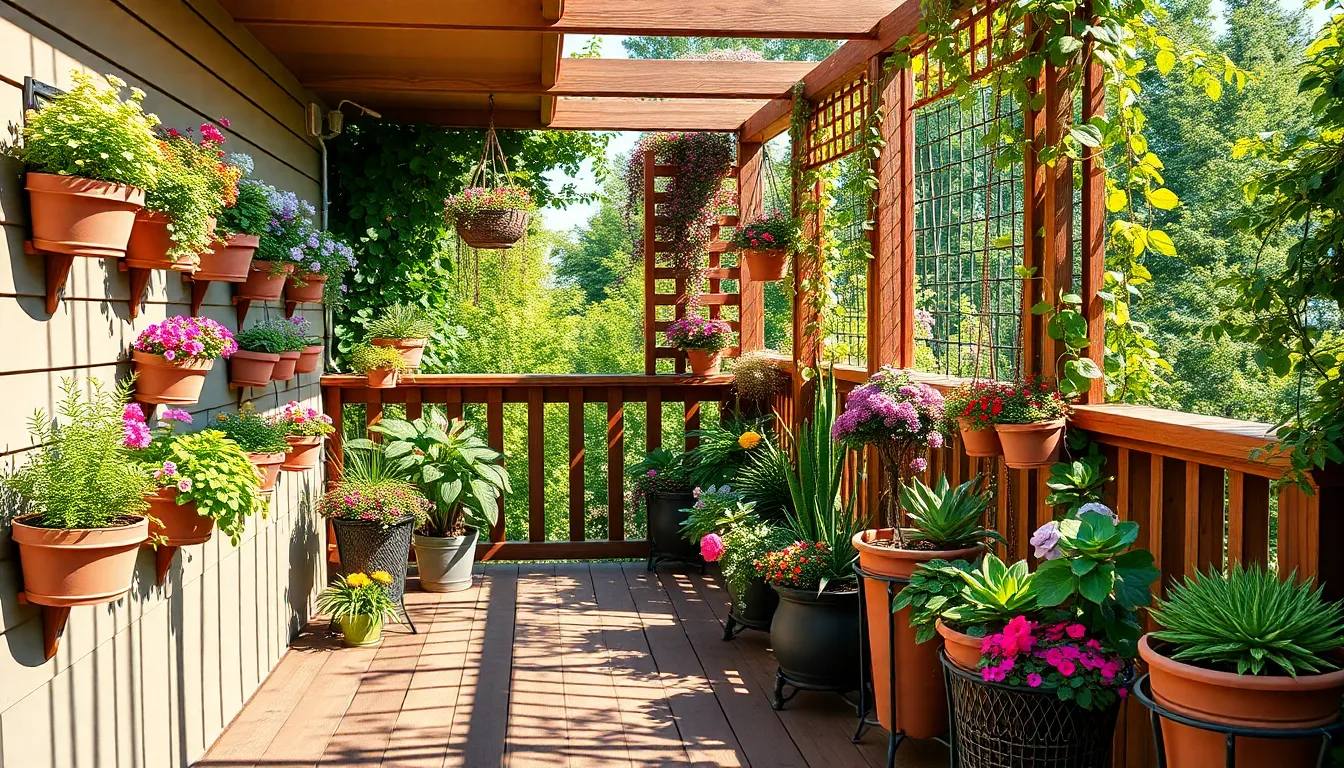
Vertical garden displays maximize limited deck space by transforming walls into stunning plant showcases. Wall-mounted planters hold various species including flowers, herbs, and succulents while creating vibrant layered effects that add color and texture without consuming floor space.
Install Hanging Planters and Wall-Mounted Containers
Hanging planters free up valuable floor space while creating eye-catching floating garden displays. We recommend choosing colorful containers filled with easy-care annuals like petunias, verbena, or nasturtium to attract butterflies and provide continuous color. Installing these planters along railings, eaves, or pergolas creates stunning height variation that adds charm and visual interest to any deck space.
Wall-mounted containers offer permanent answers for vertical gardening on decks. These fixtures can accommodate multiple plant varieties and create living walls that serve as natural privacy screens. Mounting containers at different heights generates ever-changing visual patterns while maximizing growing space in compact areas.
Build DIY Trellis Systems for Climbing Plants
Trellis systems provide essential structural support for climbing plants like roses, vines, and clematis on decks. Building custom trellises using wood or metal materials allows perfect integration with existing deck design elements. These vertical structures create natural walls of greenery and flowers that enhance privacy while adding romantic garden aesthetics.
DIY trellis construction enables customization based on exact plant needs and deck dimensions. We suggest positioning trellises strategically to support climbing plant growth while creating beautiful backdrop features. Wooden trellises blend seamlessly with natural deck materials, while metal options offer modern architectural appeal.
Arrange Tiered Plant Stand Configurations
Tiered plant stands create organized displays that showcase plants at varying heights and sizes. These configurations work perfectly for grouping herb gardens, flowering annuals, or succulents in compact arrangements that maximize visual impact. Combining different container shapes and colors on tiered stands creates focal points that enliven deck spaces.
Multi-level plant arrangements allow us to display diverse plant collections efficiently while maintaining easy access for care and maintenance. Positioning taller plants on higher tiers and shorter varieties below creates natural cascading effects. Strategic placement of tiered stands fills empty deck corners while adding lush greenery and diverse textures to outdoor living areas.
Design Container Gardens with Varied Heights and Textures
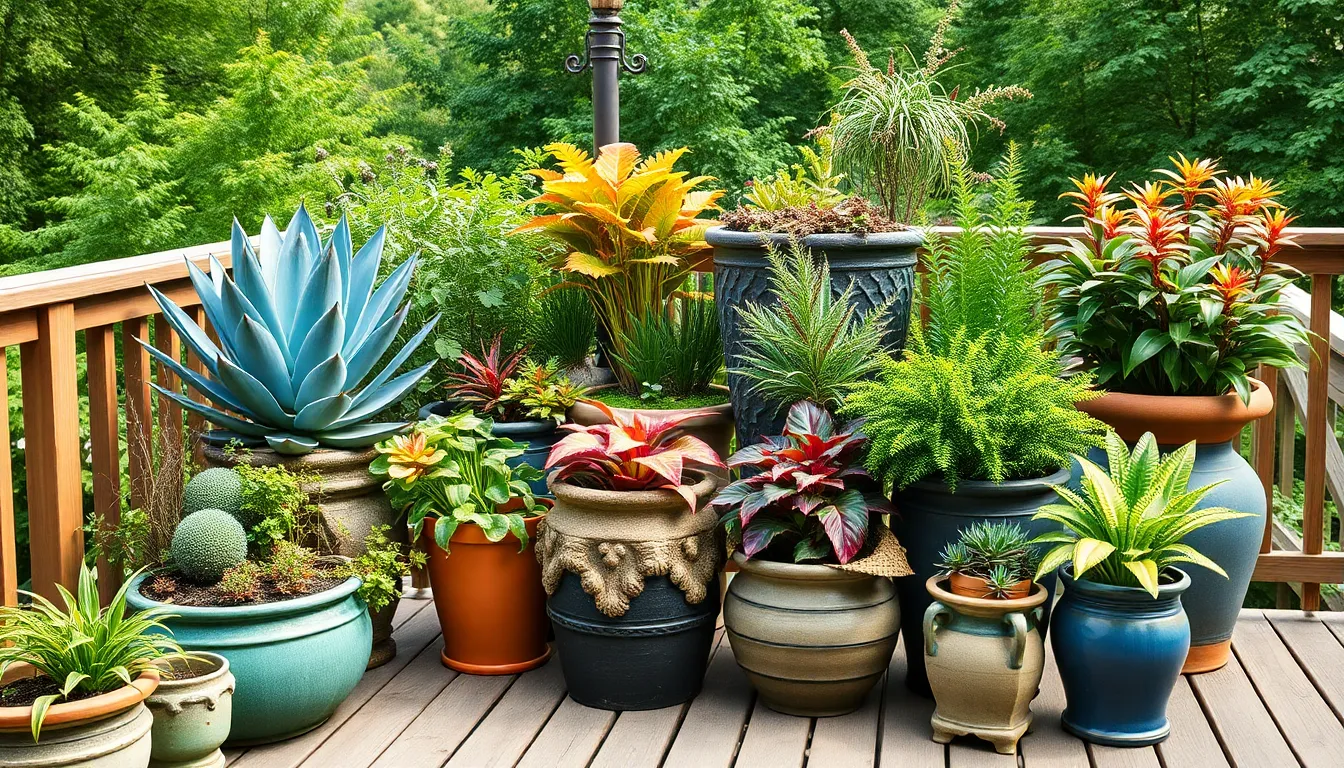
Creating visual dimension on your deck requires strategic container placement and thoughtful plant selection. We’ll transform your outdoor space into a ever-changing botanical display using varied heights, textures, and strategic groupings.
Mix Large Statement Planters with Smaller Accent Pots
Position large planters strategically in corners or as focal points to anchor your deck design. Bold plants like coralbark maples, pink cherry trees, or blue agave serve as living sculptures that command attention and create natural gathering spots.
Surround these statement pieces with smaller pots containing complementary accent plants. Succulents, ferns, ivy, or caladiums fill in spaces while adding layers of interest without overwhelming your larger displays.
Use repetition of plant types or colors in smaller containers to tie your design together. This creates rhythm and harmony across your deck space, connecting different areas through consistent visual elements.
Combine Different Plant Textures and Foliage Colors
Integrate diverse foliage textures by mixing smooth, spiky, feathery, and broad leaves throughout your container arrangements. Combining different leaf shapes and structures creates captivating contrast that enhances your overall deck aesthetic.
Vary your foliage colors from deep greens to variegated or bluish hues to add vibrant visual interest. Succulents with their muted tones contrast beautifully with lush, leafy plants like ferns or trailing ivies.
Consider plants with colorful leaves or seasonal flowering varieties to maintain pops of color that enliven your deck throughout different seasons. These strategic color choices ensure your container gardens remain visually appealing year round.
Group Containers in Odd Numbers for Visual Appeal
Arrange containers in groups of three, five, or seven to achieve natural, balanced visual appeal. Odd groupings create more ever-changing and pleasing arrangements than symmetrical pairs or even numbered displays.
Mix shapes, sizes, and plant types within these groups to encourage a natural and inviting look. This varied approach mimics how plants naturally grow in outdoor environments, creating an organic feel on your deck.
Use natural toned containers like stone or off white materials to allow your plant colors and textures to stand out. These neutral container choices prevent overwhelming your design while highlighting the natural beauty of your botanical selections.
Establish Privacy Screens Using Strategic Plant Placement
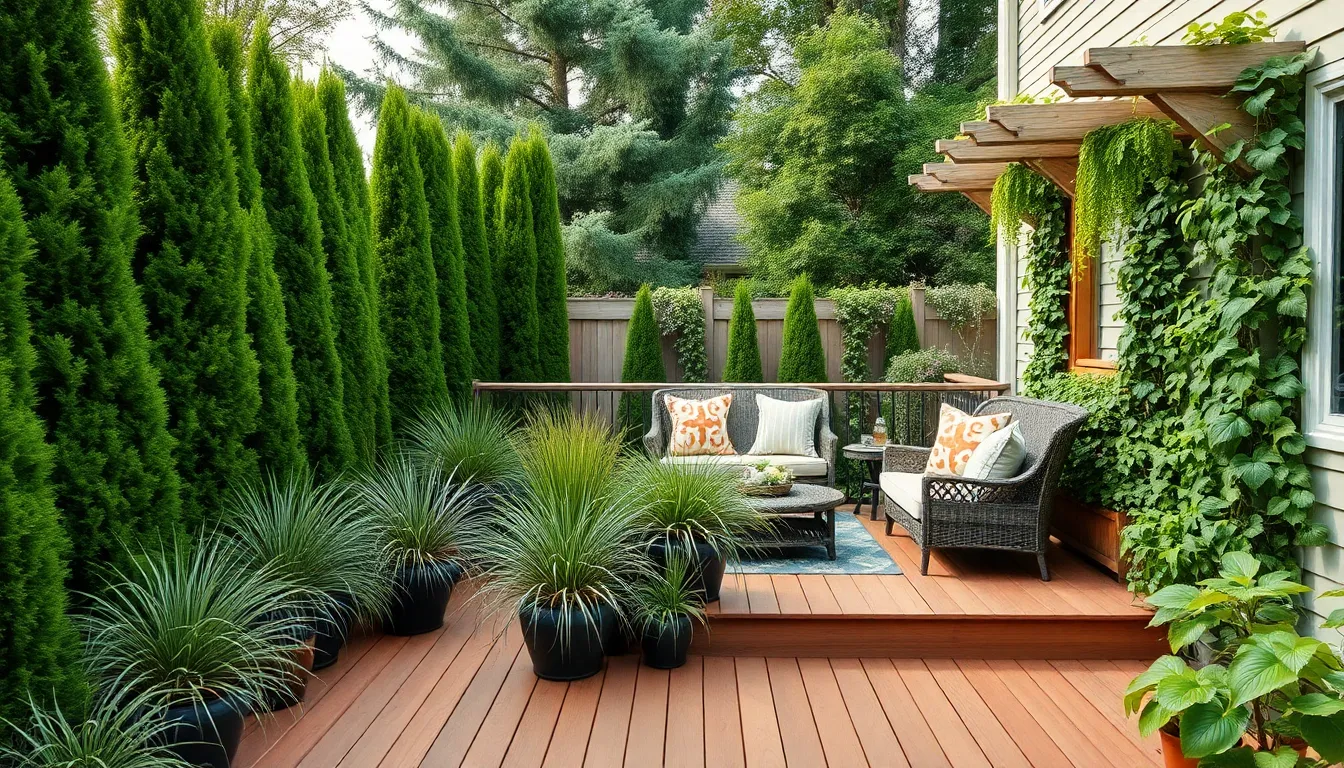
Building on our container garden foundation, we’ll now focus on creating natural privacy answers that transform your deck into a secluded retreat. Strategic plant placement lets us establish living barriers that enhance both beauty and seclusion.
Position Tall Plants Along Deck Perimeters
Evergreen selections like arborvitae and boxwood work exceptionally well along deck edges because they maintain foliage year-round. We recommend placing these tall specimens around your deck’s perimeter to create consistent privacy screens that won’t leave you exposed during winter months. Arborvitae varieties can reach heights of 10-15 feet, making them perfect natural barriers that visually separate your space from neighbors or street views.
Container placement becomes crucial when positioning these perimeter plants. We suggest using large, stable planters that can support mature root systems while preventing wind damage. Boxwood thrives in containers and offers dense, compact growth that’s easy to maintain compared to other evergreen options.
Spacing considerations matter significantly for achieving proper coverage. We typically space tall plants 3-4 feet apart along deck railings to ensure adequate growth room while maintaining privacy continuity as plants mature.
Create Natural Barriers with Dense Shrubs and Grasses
Evergreen shrubs provide the most reliable year-round screening because they retain their leaves through all seasons. We find that combining evergreen varieties with deciduous options creates layered texture while ensuring you’ll never lose complete privacy coverage. Dense evergreen shrubs form living fences that effectively block sightlines from multiple angles.
Ornamental grasses add movement and softness to your privacy screens while growing quickly to fill gaps. We recommend varieties like fountain grass or miscanthus that create thick clusters reaching 4-6 feet in height. These grasses work particularly well when mixed with shrubs to create natural-looking barriers.
Deciduous alternatives offer seasonal beauty with spring flowers and fall color changes. Even after leaves drop, we’ve found that the branch structure of deciduous shrubs still provides partial visual obstruction during winter months.
Use Bamboo and Ornamental Plants for Quick Coverage
Bamboo varieties grow rapidly and can reach impressive heights within a single growing season. We recommend clumping bamboo types over running varieties to prevent aggressive spreading that could damage deck structures. Container-grown bamboo gives us excellent control while providing the tropical aesthetic many homeowners desire.
Climbing vines on trellises create vertical green walls that maximize privacy in minimal floor space. We suggest jasmine and clematis varieties that produce beautiful flowers while growing dense foliage coverage. These climbing plants can reach 8-12 feet when properly supported by lattice structures.
Trellis systems along deck edges let us create customizable privacy screens that adjust as plants mature. We often combine multiple trellis panels to create continuous living walls that can be modified or relocated as needed throughout the growing season.
Incorporate Edible Plants for Functional Beauty
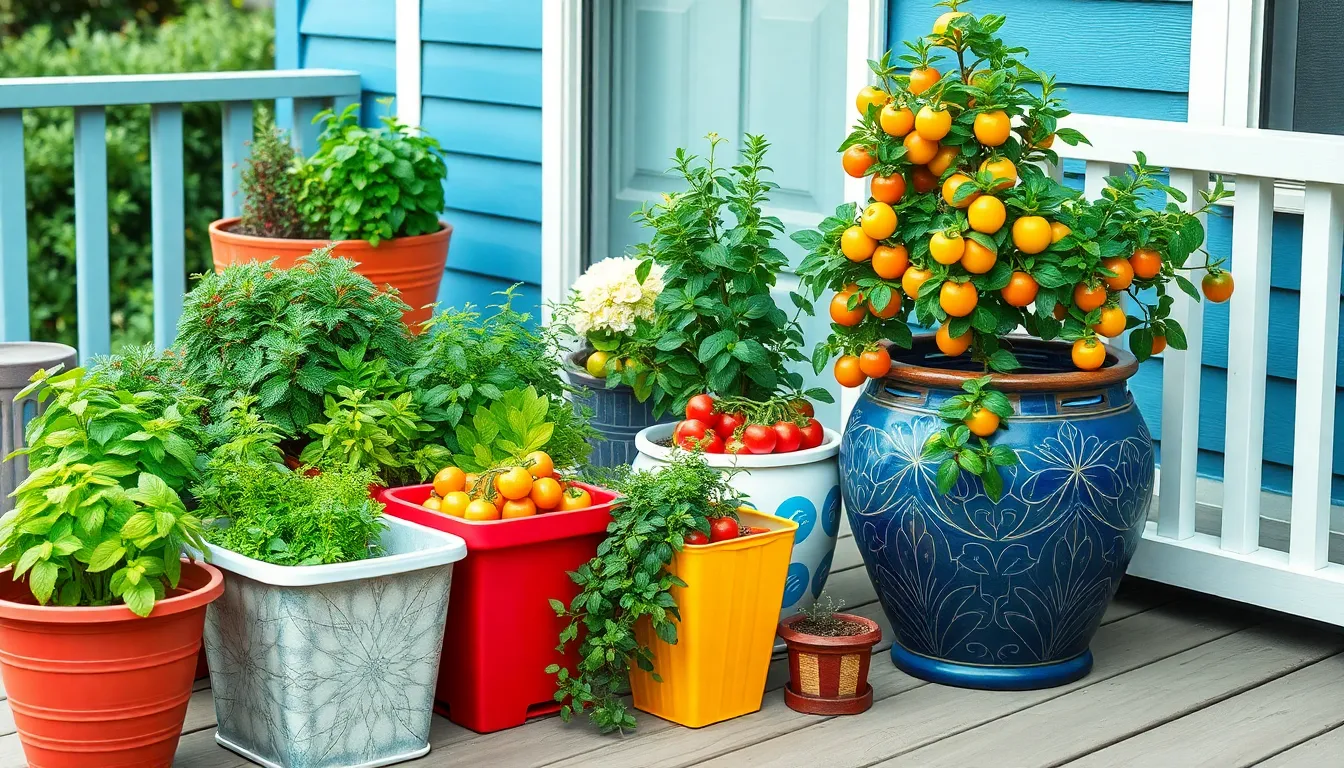
Now that we’ve established privacy and visual appeal, let’s enhance our deck’s functionality by integrating plants that offer both ornamental beauty and practical benefits. Edible plants transform outdoor spaces into productive gardens while maintaining aesthetic charm.
Grow Herbs in Accessible Container Gardens
Herbs thrive exceptionally well in deck containers and provide the perfect introduction to functional gardening. We recommend starting with low-maintenance varieties like basil, thyme, and mint that flourish in stylish pots while offering fresh ingredients for daily cooking.
Container herb gardens offer several advantages for deck decorating. They’re easily accessible for harvesting, require minimal maintenance, and can be arranged in visually appealing groupings. Popular herbs such as basil and thyme add delightful fragrance to outdoor spaces while serving practical culinary purposes.
Strategic placement of herb containers allows us to create aromatic zones throughout our deck. Positioning these fragrant plants near seating areas enhances the sensory experience while keeping cooking essentials within arm’s reach. The natural scents from herbs like mint and thyme create an inviting atmosphere that complements our privacy plantings.
Plant Vegetables in Raised Deck Planters
Raised planters provide optimal growing conditions for vegetables on decks by offering superior soil control and drainage management. We’ve found that cherry tomatoes, peppers, and leafy greens perform exceptionally well in these elevated containers while adding vibrant colors to our outdoor displays.
Vegetables grown in raised deck planters create stunning visual impact through their diverse textures and seasonal changes. Cherry tomatoes cascade beautifully over planter edges, while peppers provide bold splashes of red, yellow, and orange. Leafy greens like lettuce and spinach offer lush, verdant backdrops that complement flowering plants.
Proper planter selection ensures vegetable success on our decks. We recommend choosing containers with adequate depth for root development and drainage holes to prevent waterlogging. Raised planters also make harvesting more comfortable while creating defined growing zones that integrate seamlessly with our decorative plant arrangements.
Add Fruit Trees in Large Decorative Pots
Compact fruit trees in large decorative pots serve as stunning focal points while providing fresh, homegrown produce. Dwarf citrus and fig trees work particularly well for deck cultivation, offering both structural height and seasonal fruit production in manageable containers.
Large decorative pots accommodate the root systems that fruit trees require while maintaining mobility for seasonal adjustments. We can move these containers to optimize sun exposure or protect them during harsh weather conditions. The substantial size of these planters also adds visual weight and anchors our overall deck design.
Fruit trees contribute year-round interest through their changing seasonal displays. Citrus trees provide glossy evergreen foliage with fragrant blossoms, while fig trees offer broad, textured leaves that create natural privacy screens. The anticipation and harvest of fresh fruit adds an element of excitement to our deck gardening experience.
Add Seasonal Interest with Rotating Plant Displays
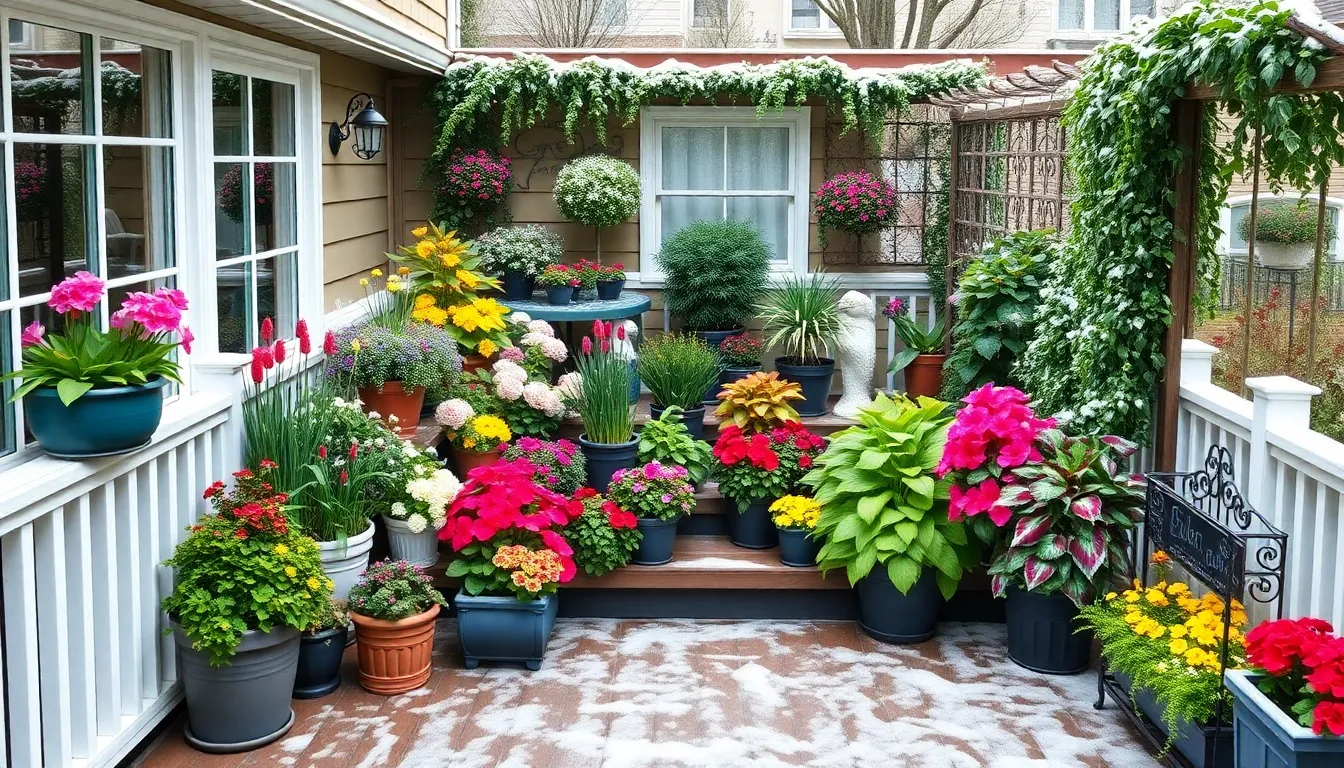
Rotating plant displays create year-round appeal and maximize your deck’s visual impact throughout changing seasons. Strategic seasonal planning ensures continuous color and texture while maintaining our beautiful outdoor botanical space.
Plan Spring Bulbs and Early Bloomers
Spring bulbs deliver fresh color and renewed life to our deck after winter’s dormancy. Tulips, daffodils, and hyacinths provide bright, cheerful blooms that create a lively spring atmosphere and signal the season’s arrival. These early bloomers thrive in containers and offer reliable performance year after year when properly planted.
Pairing spring flowers with soft pastel cushions enhances the seasonal vibe and creates cohesive outdoor decor. Floral-patterned accessories complement the natural blooms and extend the spring theme throughout our deck space. Container placement near seating areas maximizes our enjoyment of these fragrant early bloomers.
Staggered planting times extend the spring display from early March through late May. Different bulb varieties bloom at various intervals, ensuring continuous color as the season progresses. This approach prevents gaps in our spring display and maintains visual interest during the transition to summer plants.
Select Summer Flowering Plants for Peak Color
Summer flowering plants deliver vibrant blooms and lush foliage during the warmest months when we spend most time outdoors. Easy-care annuals like petunias, bacopa, lantana, and hibiscus provide continuous color with minimal maintenance requirements. Grouping these varieties in containers creates stunning focal points that anchor our deck’s summer design.
Color schemes should complement our deck or house architecture for maximum visual impact. Warm reds, oranges, and yellows create hot palettes that energize the space, while blues and whites offer cooler, more serene atmospheres. Strategic color coordination ties our plant displays to existing outdoor furniture and decor elements.
Succulents like sedums and echeverias add texture and drought-resistant greenery to summer arrangements. These low-maintenance plants thrive in hot conditions and require less frequent watering than traditional annuals. Mixed plantings combining succulents with flowering annuals create ever-changing container gardens with varied textures and bloom times.
Choose Fall Foliage and Winter-Hardy Options
Fall plants with striking foliage bring warm tones of reds, oranges, and yellows to our autumn deck displays. Container-grown dwarf conifers and Japanese maples showcase beautiful fall color while adding structural elements to our plant arrangements. These compact trees provide vertical interest and serve as seasonal focal points.
Tiered planters maximize visual impact and optimize limited deck space during fall transitions. Arranging autumn varieties at different heights creates depth and allows each plant’s unique characteristics to shine. This layered approach showcases fall foliage colors more effectively than single-level displays.
Winter-hardy plants and evergreens maintain greenery and structure through colder months when most plants go dormant. Hardy shrubs and conifers in sturdy planters withstand harsh weather conditions and keep our deck looking inviting year-round. These permanent plantings provide the backbone for seasonal rotation displays.
Climbing vines and trailing greenery on trellises bring life to winter decks without consuming valuable floor space. Evergreen varieties like ivy or wintercreeper maintain coverage through cold seasons while deciduous vines offer seasonal changes. Vertical growing answers maximize our winter plant displays even though reduced growing conditions.
Enhance Ambiance with Fragrant Plant Selections
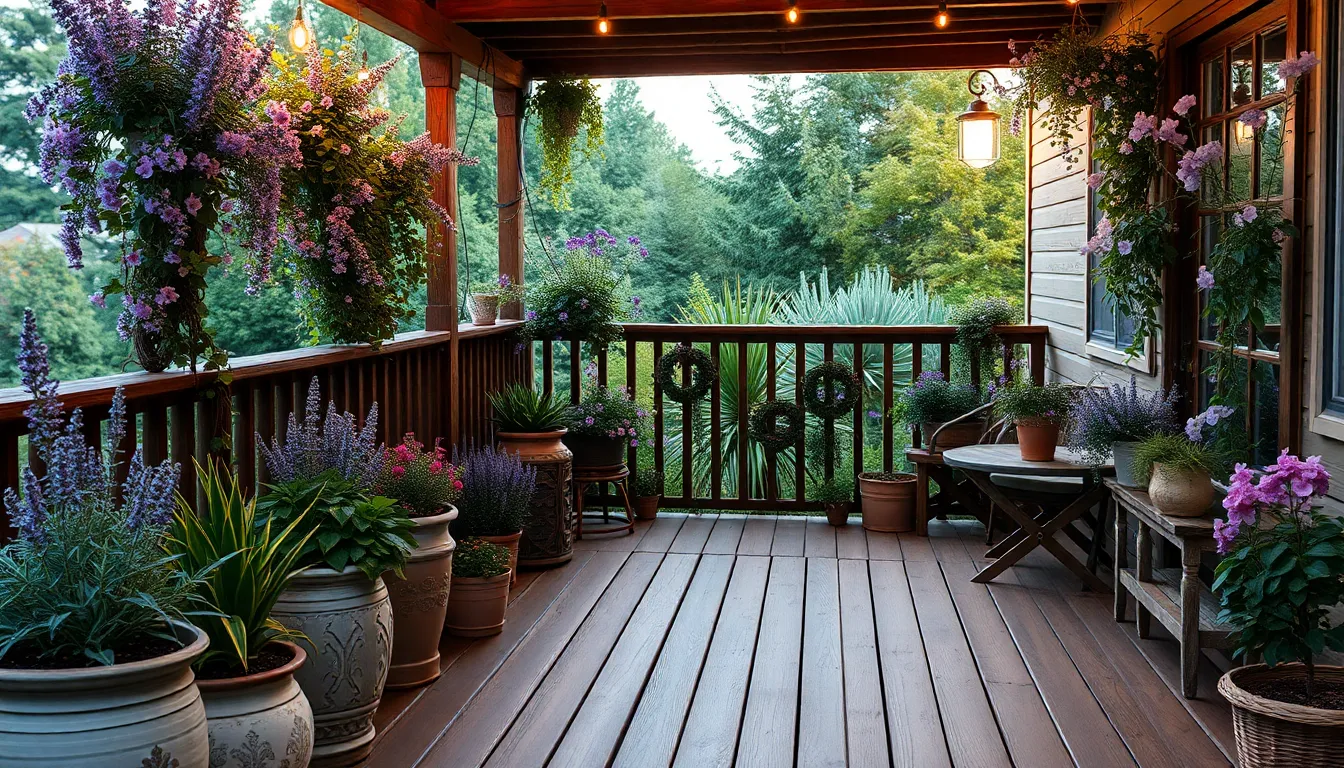
Creating a sensory-rich outdoor experience transforms your deck into a truly immersive retreat. Fragrant plants add an invisible layer of luxury that engages your guests’ senses and creates lasting memories.
Position Aromatic Herbs Near Seating Areas
Lavender containers placed directly beside lounge chairs release their calming scent every time you brush against them. We recommend positioning these aromatic herbs within arm’s reach of your primary seating areas to maximize their sensory impact.
Rosemary planters work exceptionally well near dining tables where their woody fragrance complements outdoor meals. Strategic placement of these herbs in decorative containers lets you enjoy their natural aromatherapy benefits while entertaining guests.
Mint varieties thrive in portable pots that you can move closer to conversation areas during gatherings. Fresh mint leaves release their invigorating scent when touched, creating an interactive element that guests love to experience.
Include Night-Blooming Flowers for Evening Enjoyment
Evening primrose opens its delicate blooms as the sun sets, filling your deck with sweet fragrance during twilight hours. We suggest planting these night bloomers in containers positioned near your evening seating areas for maximum impact.
Moonflowers unfurl their large white blooms after dark, releasing an intoxicating perfume that transforms evening gatherings into magical experiences. These climbing annuals work beautifully in large containers with supportive stakes or small trellises.
Four o’clock flowers begin releasing their spicy-sweet fragrance in late afternoon, bridging the gap between day and evening entertainment. Their compact growth habit makes them perfect for adding fragrant accents to existing container arrangements.
Plant Fragrant Climbing Vines on Railings
Sweet pea vines cascade over deck railings while releasing their delicate floral fragrance throughout the growing season. Installing simple wire supports or small trellises gives these climbers the structure they need to create aromatic living walls.
Honeysuckle varieties provide intense evening fragrance that carries across your entire deck space. We recommend choosing container-friendly cultivars that won’t overwhelm your railing system while still delivering maximum scent impact.
Climbing roses offer both visual beauty and classic fragrance when trained along deck railings or pergola supports. Fragrant varieties like ‘Eden’ or ‘New Dawn’ provide continuous blooms and scent throughout the growing season when planted in large containers with proper support structures.
Maintain Your Deck Plant Displays Year-Round
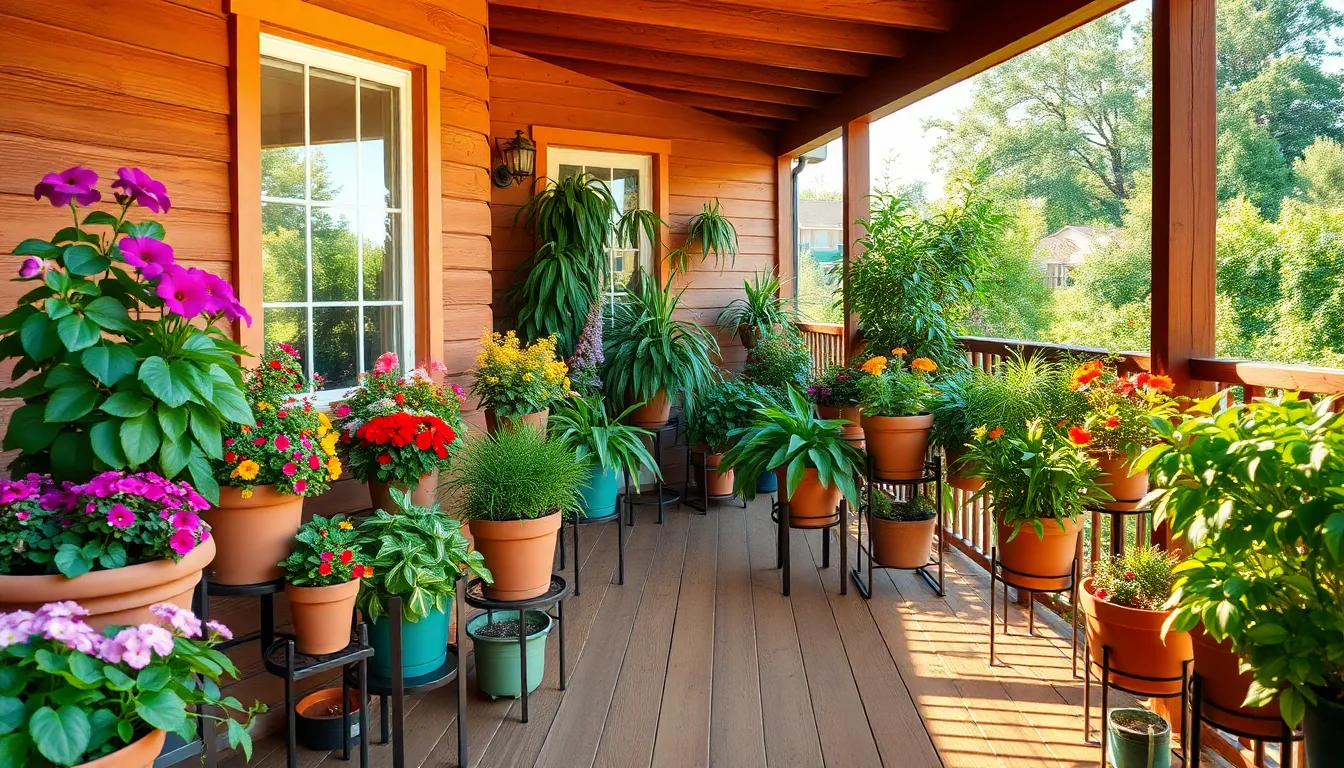
Maintaining vibrant deck plants throughout every season requires strategic care and attention to detail. We’ll help you create sustainable systems that keep your botanical displays thriving regardless of weather conditions.
Establish Proper Watering and Drainage Systems
Watering frequency increases dramatically for deck container plants compared to ground plantings. Morning watering sessions prove most effective since they reduce evaporation rates and allow plants maximum moisture absorption time. Container plants typically need daily attention during hot summer months, while spring and fall watering can occur every other day.
Drainage holes become absolutely critical for preventing waterlogging and root damage. We recommend avoiding rocks at container bottoms since they create ineffective drainage systems. Proper drainage holes paired with quality potting soil deliver superior results for plant health.
Elevating planters protects both plants and deck surfaces from moisture damage. Pot feet or plant stands create essential air circulation underneath containers while preventing water stains on decking materials. This elevation strategy also helps us monitor drainage effectiveness and prevents standing water accumulation.
Plan Seasonal Care and Plant Rotation Schedules
Fertilizing container plants requires specialized formulations designed for potted environments. We adjust nutrient applications based on exact plant species and seasonal growth patterns. Spring feeding supports new growth emergence, while summer applications maintain blooming performance.
Pruning schedules focus on late winter and early spring timing for optimal plant health. Dead heading faded flowers promotes continuous blooming throughout growing seasons. Regular maintenance pruning keeps plants compact and prevents overcrowding in container arrangements.
Seasonal plant rotation maximizes sunlight exposure and weather adaptation strategies. We select varieties suited to our hardiness zones and exact deck conditions like sun or shade patterns. Cool season plants transition to warm season varieties as temperatures shift, ensuring continuous visual appeal.
Protect Plants from Extreme Weather Conditions
Extreme heat protection starts with thorough morning watering sessions that prevent plant stress. We move sensitive plants to shadier deck areas during heat waves and provide temporary shade cloth coverage when necessary. Mulching container surfaces helps retain soil moisture during scorching summer days.
Cold weather preparation involves relocating tender plants indoors or creating protective barriers. Wind breaks using temporary screens shield plants from harsh winter conditions. We group containers together to create microclimates that offer mutual protection from freezing temperatures.
Regular deck maintenance prevents mold and mildew buildup from retained planter moisture. Cleaning schedules include removing fallen leaves and debris that trap excess water around container bases. Proper spacing between planters ensures adequate air circulation and reduces humidity related problems.
Conclusion
We’ve covered everything you need to transform your deck into a stunning botanical oasis that’ll be the envy of your neighborhood. From selecting the right plants for your exact conditions to creating privacy screens with living barriers your deck can become a true outdoor sanctuary.
Remember that successful deck decorating with plants isn’t just about filling containers—it’s about creating a cohesive design that works with your space climate and lifestyle. Whether you’re growing fresh herbs for cooking or establishing fragrant evening blooms the key is planning with intention.
With proper maintenance and seasonal rotation strategies your deck garden will provide year-round beauty and enjoyment. Start small with a few well-chosen containers and gradually expand as you gain confidence. Your outdoor space will soon become your favorite retreat.
Frequently Asked Questions
What plants work best for a full sun deck?
Vibrant flowering plants thrive in full sun conditions. Consider petunias, hibiscus, marigolds, and geraniums for continuous blooms. These plants can handle direct sunlight and heat while providing beautiful colors throughout the growing season. Pair them with heat-tolerant herbs like rosemary and thyme for both beauty and functionality.
How can I create privacy on my deck using plants?
Use tall evergreen plants like arborvitae and boxwood around deck perimeters for year-round privacy screens. Dense shrubs, ornamental grasses, and bamboo create effective natural barriers. Add climbing vines on trellis systems to maximize vertical space without taking up floor area, creating a secluded retreat atmosphere.
What are the best container gardening tips for small decks?
Maximize vertical space with wall-mounted planters, hanging baskets, and tiered plant stands. Use varied container heights and group pots in odd numbers for visual balance. Choose natural-toned containers to highlight plant colors, and mix large statement planters with smaller accent pots for depth and dimension.
How do I maintain deck plants year-round?
Water plants in the morning and ensure proper drainage by elevating containers. Establish seasonal care schedules including specialized fertilizing and pruning. Protect plants from extreme weather with covers or moving containers indoors. Regular deck cleaning prevents mold and mildew buildup that can damage both plants and deck surfaces.
Can I grow edible plants on my deck?
Yes! Herbs like basil, thyme, and mint thrive in containers and provide fresh cooking ingredients. Vegetables such as cherry tomatoes, peppers, and leafy greens grow well in raised deck planters. Consider compact fruit trees like dwarf citrus or figs in large decorative pots for stunning focal points.
How do I choose plants for shaded decks?
Select shade-tolerant plants like hostas, ferns, begonias, and impatiens for areas with limited sunlight. These plants thrive in partial to full shade conditions while still providing beautiful foliage and flowers. Consider the specific light patterns on your deck throughout the day when making plant selections.
What plants provide the best fragrance for deck spaces?
Position aromatic herbs like lavender and rosemary near seating areas for calming scents. Night-blooming flowers such as evening primrose and moonflowers add fragrance for evening enjoyment. Fragrant climbing vines like sweet pea and honeysuckle on railings provide delightful aromas throughout the growing season.
How can I ensure my deck plants look good in all seasons?
Plan seasonal rotations with spring bulbs, summer annuals, fall foliage plants, and winter-hardy evergreens. Stagger planting times to extend displays and incorporate a mix of cool-season and warm-season plants. Use dwarf conifers and climbing vines to maintain structure and greenery during dormant months.

